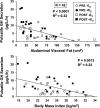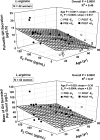Regulation of basal, pulsatile, and entropic (patterned) modes of GH secretion in a putatively low-somatostatin milieu in women
- PMID: 19491298
- PMCID: PMC2724111
- DOI: 10.1152/ajpendo.00136.2009
Regulation of basal, pulsatile, and entropic (patterned) modes of GH secretion in a putatively low-somatostatin milieu in women
Abstract
Somatostatin (SS) released by hypothalamic neurons inhibits GH exocytosis noncompetitively. Therefore, we postulated that attenuation of GH feedback-induced SS outflow would help to unmask covariates of endogenous secretagogue drive. To this end, 42 healthy pre- and postmenopausal women were randomly assigned to receive leuprolide plus estradiol (E(2)) or leuprolide plus placebo. A putatively low-SS milieu was imposed by L-arginine infusion. Deconvolution and regularity analyses were applied to 6-h GH concentration-time profiles. By two-way ANOVA, age negatively (P < 0.001) and E(2) positively (P = 0.001) determined pulsatile GH secretion in the presumptively SS-deficient milieu (P < 0.001). Comparable effects were exerted on the mass of GH secreted per burst per unit distribution volume (age P = 0.001, E(2) P < 0.001, overall P < 0.001). E(2) alone predicted basal (nonpulsatile) GH secretion (P = 0.004). Stepwise forward-selection multivariate regression demonstrated that age (P = 0.0017) and E(2) (P = 0.0002) together explained 46% of intersubject variability in pulsatile GH secretion (P < 0.001) and fully replaced the negative univariate effect of abdominal visceral fat (r(2) = 0.32, P < 0.001). Moreover, age and E(2) (but not AVF) interacted to supervise GH regularity (P = 0.007). We conclude that age and E(2) availability individually and together constitute primary predictors of basal, pulsatile, and patterned GH secretion in an inferentially feedback-silenced context in healthy women. Therefore, both factors must be considered in framing hypotheses of endogenous GH drive.
Figures






Similar articles
-
Pre- versus postmenopausal age, estradiol, and peptide-secretagogue type determine pulsatile growth hormone secretion in healthy women: studies using submaximal agonist drive and an estrogen clamp.J Clin Endocrinol Metab. 2010 Jan;95(1):353-60. doi: 10.1210/jc.2009-1769. Epub 2009 Oct 26. J Clin Endocrinol Metab. 2010. PMID: 19858315 Free PMC article. Clinical Trial.
-
Relative effects of estrogen, age, and visceral fat on pulsatile growth hormone secretion in healthy women.Am J Physiol Endocrinol Metab. 2009 Aug;297(2):E367-74. doi: 10.1152/ajpendo.00230.2009. Epub 2009 May 26. Am J Physiol Endocrinol Metab. 2009. PMID: 19470834 Free PMC article. Clinical Trial.
-
Continuous 24-hour intravenous infusion of recombinant human growth hormone (GH)-releasing hormone-(1-44)-amide augments pulsatile, entropic, and daily rhythmic GH secretion in postmenopausal women equally in the estrogen-withdrawn and estrogen-supplemented states.J Clin Endocrinol Metab. 2001 Feb;86(2):700-12. doi: 10.1210/jcem.86.2.7195. J Clin Endocrinol Metab. 2001. PMID: 11158034
-
Three-peptide control of pulsatile and entropic feedback-sensitive modes of growth hormone secretion: modulation by estrogen and aromatizable androgen.J Pediatr Endocrinol Metab. 2003 May;16 Suppl 3:587-605. J Pediatr Endocrinol Metab. 2003. PMID: 12795360 Review.
-
Neurophysiological regulation and target-tissue impact of the pulsatile mode of growth hormone secretion in the human.Growth Horm IGF Res. 2001 Jun;11 Suppl A:S25-37. doi: 10.1016/s1096-6374(01)80005-8. Growth Horm IGF Res. 2001. PMID: 11527085 Review.
References
-
- Aguila MC, McCann SM. Growth hormone increases somatostatin release and messenger ribonucleic acid levels in the rat hypothalamus. Brain Res 623: 89–94, 1993. - PubMed
-
- Akaike H A new look at the statistical model identification. IEEE Trans Autom Control 19: 716–723, 1974.
-
- Alba-Roth J, Muller OA, Schopohl J, Von Werder K. Arginine stimulates growth hormone secretion by suppressing endogenous somatostatin secretion. J Clin Endocrinol Metab 67: 1186–1189, 1988. - PubMed
-
- Baumbach WR, Carrick TA, Pausch MH, Bingham B, Carmignac D, Robinson IC, Houghten R, Eppler CM, Price LA, Zysk JR. A linear hexapeptide somatostatin antagonist blocks somatostatin activity in vitro and influences growth hormone release in rats. Mol Pharmacol 54: 864–873, 1998. - PubMed
-
- Bray MJ, Vick TM, Shah N, Anderson SM, Rice LW, Iranmanesh A, Evans WS, Veldhuis JD. Short-term estradiol replacement in postmenopausal women selectively mutes somatostatin's dose-dependent inhibition of fasting growth hormone secretion. J Clin Endocrinol Metab 86: 3143–3149, 2001. - PubMed
Publication types
MeSH terms
Substances
Grants and funding
LinkOut - more resources
Full Text Sources

